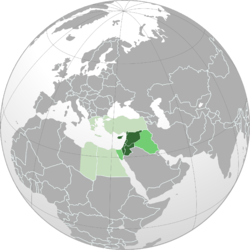லெவண்ட்
இக்கட்டுரையின் தலைப்பு விக்கிப்பீடியாவின் பெயரிடல் மரபுக்கோ, கலைக்களஞ்சிய பெயரிடல் மரபுக்கோ ஒவ்வாததாக இருக்கலாம் இக்கட்டுரையின் தலைப்பினை பெயரிடல் மரபுக்கு ஏற்றவாறு மாற்றக் கோரப்பட்டுள்ளது. உங்கள் கருத்துக்களை உரையாடல் பக்கத்தில் தெரிவியுங்கள். |
| லெவண்ட் | |
|---|---|
 | |
| நாடுகளும் பகுதிகளும் | (ஹடாய் மாகாணம்) |
| மக்கட்தொகை | 44,550,926[4] |
| Demonym | லெவண்டைன் |
| மொழிகள் | அரபு மொழி, எபிரேயம், புது அரமேய மொழி, ஆர்மீனியன், கிரேக்கம், குர்தி மொழி, துருக்கிய மொழி |
| நேர வளையங்கள் | கிழக்கு ஐரோப்பிய நேரம்+02:00 (துருக்கி மற்றும் சைப்பிரஸ்) |

லெவண்ட் (Levant) (/ləˈvænt/; அரபு: المشرق /ʔal-maʃriq/[1][5][6][7][8][9][10]) என்பது கிழக்கு மத்தியதரைக் கடலில் அமைந்த சைப்பிரசு, மற்றும் நிலநடுக்கடலின் கிழக்கே அமைந்த வடக்கு அரேபிய தீபகற்பத்தின் பகுதிகளான இசுரேல், யோர்தான், லெபனான், பாலத்தீனம், சிரியா, தெற்கு துருக்கி அடங்கிய பகுதிகளை குறிக்கும்.[11]
13-14ஆம் நூற்றாண்டுகளில் லெவண்ட் என்ற சொல்லால், இத்தாலிய வணிக கப்பல்களின் மாலுமிகள், கிழக்கு மத்தியதரைக்கடல் நாடுகளை, குறிப்பாக கிரேக்கம், அனத்தோலியா , சிரியா மற்றும் பாலஸ்தீனம் ஆகிய நாடுகளைக் குறித்தனர். 1581இல் வணிகம் செய்யும் நோக்கில், ஆங்கிலேய வணிக நிறுவனம், லெவண்ட் கம்பெனி என்ற வணிக நிறுவனத்தை நிறுவி ஆட்டோமன் பேரரசில் வணிகம் செய்தது.
நிலநடுக்கடல், மேற்காசியாவின் லெவண்ட் பகுதியை, வடகிழக்கு ஆப்பிரிக்காவை இணைக்கும் சாலையாக அமைந்துள்ளது.[12]
மக்கள், சமயம் மற்றும் பண்பாடு[தொகு]
லெவண்ட் பகுதியின் மக்கள்[13][14][15] சன்னி, ஷியா, சலாபி, குர்து, யாசிதி, இஸ்மாயிலி இசுலாமியர்களையும், யூதர்களையும், கிறித்துவர்களையும் கொண்டது. மேலும் லெவண்ந்திய மக்களில் அரபியர்கள், துருக்கியர்கள், அசிரியர்கள், ஆர்மினியர்கள் மற்றும் சால்டியர்கள் மக்கள் இனக் குழுக்களைக் கொண்டுள்ளது.
இப்பகுதியில் உள்ள மக்கள் அரபு, எபிரேயம், கிரேக்கம், ஆர்மினியன் மொழி, பிரான்சு, துருக்கி மொழி மற்றும் ஆங்கிலம் போன்ற மொழிகளை பேசுகின்றனர்.
படக்காட்சிகள்[தொகு]
-
சைப்பிரஸ் மற்றும் இசுரேல் நாடுகளைக் காட்டும் செய்மதி படங்கள்
-
அரபு ஆண்களின் நாட்டுப்புற ஆடல்
-
சிரியாவின் டமாஸ்கஸ் நகர சதுக்கம்
-
ஜோர்டான் ஆற்றில் ஞானஸ்னாம் செய்தல்
-
நெப்போ மலை, யோர்தான்
-
சிரியாவின் ஹமா நகரம்
அடிக்குறிப்புகள்[தொகு]
- ↑ 1.0 1.1 1.2 The Oxford Encyclopedia of Ancient Greece and Rome, Volume 1, p247, "Levant"
- ↑ Microsoft Encarta (2009) "Levant"
- ↑ Oxford Dictionaries Online. "Levant." Oxford University Press. Retrieved 4 April 2015.
- ↑ Population found by adding all the countries' populations (Cyprus, Israel, Jordan, Lebanon, Syria, Palestine and Hatay Province)
- ↑ Naim, Samia, Dialects of the Levant, in Weninger, Stefan et al. (eds.), The Semitic Languages: An International Handbook, Berlin/Boston: Walter de Gruyter (2011), p. 921
- ↑ Amy Chua (2004), World on Fire: How Exporting Free Market Democracy Breeds Ethnic Hatred and Global Instability p. 212
- ↑ Mandyam Srinivasan, Theodore Stank, Philippe-Pierre Dornier, Kenneth Petersen (2014), Global Supply Chains: Evaluating Regions on an EPIC Framework – Economy, Politics, Infrastructure, and Competence: “EPIC” Structure – Economy, Politics, Infrastructure, and Competence, p. 3
- ↑ Ayubi, Nazih N. (1996), Over-stating the Arab State: Politics and Society in the Middle East p. 108
- ↑ David Thomas, Alexander Mallett (2012), Christian-Muslim Relations. A Bibliographical History. Volume 4 (1200-1350), p. 145
- ↑ Jeff Lesser (1999), Negotiating National Identity: Immigrants, Minorities, and the Struggle for Ethnicity in Brazil p. 45
- ↑ Levant 1
- ↑ Egyptian Journal of Geology - Volume 42, Issue 1 - Page 263, 1998
- ↑ "Eastern Mediterranean Political Map - National Geographic Store". Shop.nationalgeographic.com. Archived from the original on 2011-10-26. பார்க்கப்பட்ட நாள் 2011-10-17.
- ↑ "Ancient Ashkelon - National Geographic Magazine". Ngm.nationalgeographic.com. 2002-10-17. பார்க்கப்பட்ட நாள் 2011-10-17.
- ↑ "The state of Israel: Internal influence driving change". BBC News. 2011-11-06. http://www.bbc.co.uk/news/world-middle-east-15479879.
மேற்கோள்கள்[தொகு]
- Fernand Braudel, The Mediterranean and the Mediterranean World in the Age of Phillip II
- Julia Chatzipanagioti: Griechenland, Zypern, Balkan und Levante. Eine kommentierte Bibliographie der Reiseliteratur des 18. Jahrhunderts. 2 Vol. Eutin 2006. பன்னாட்டுத் தரப்புத்தக எண் 3-9810674-2-8
- Levantine Heritage site. Includes many oral and scholarly histories, and genealogies for some Levantine Turkish families.
- Philip Mansel, Levant: Splendour and Catastrophe on the Mediterranean, London, John Murray, 11 November 2010, hardback, 480 pages, பன்னாட்டுத் தரப்புத்தக எண் 978-0-7195-6707-0, New Haven, Yale University Press, 24 May 2011, hardback, 470 pages, பன்னாட்டுத் தரப்புத்தக எண் 978-0-300-17264-5
வெளி இணைப்புகள்[தொகு]
| உலகின் பெரும்பகுதிகள் | ||||||||||||||||||||||||||||
|---|---|---|---|---|---|---|---|---|---|---|---|---|---|---|---|---|---|---|---|---|---|---|---|---|---|---|---|---|
|
| |||||||||||||||||||||||||||









